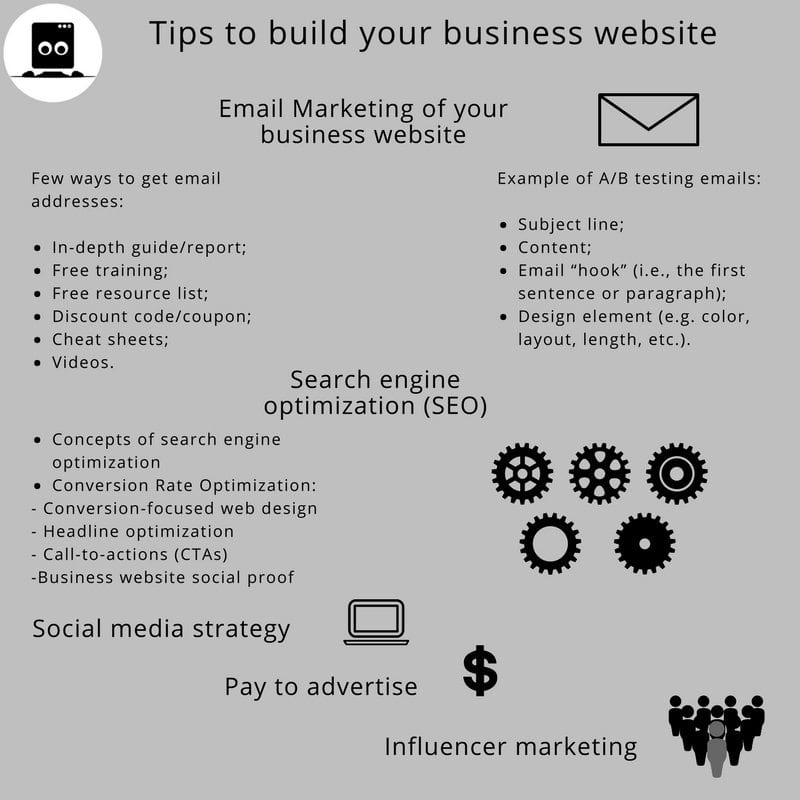You want to build your business website but don’t know where to start? This article helps you to understand how to bring traffic to your business website. Those tips will help you to understand how to communicate with your customers, plan in advance and primarily build trust.
E-mail Marketing of your Business Website
E-mail marketing is a direct channel of communication, between your business and both current and potential customers. Thus making e-mail marketing highly powerful.
In spite of this, you first need to obtain the e-mail address of your customers or potential customers. Then must figure out the best means of marketing and spike interest for everyone on your list…without spamming them.
You can use these tactics:
Lead magnets are something of value that you give away in return for an email address. The example you’re asked for your customers’ email address in exchange for the “free” download.

Few ways to obtain email addresses:
- In-depth guide/report;
- Free training;
- Free resource list;
- Discount code/coupon;
- Cheat sheets;
- Videos.
A/B Testing Emails
Having your email list segmented, give you the opportunity to attempt split testing.
Split testing (or A/B testing) just means, testing different conversion units against each other to see which your audience responds best to.
A few examples of elements within an email you would run A/B testing on:
- Subject line;
- Content;
- Email “hook” (i.e., the first sentence or paragraph);
- Design element (e.g. color, layout, length, etc.).
Automation
Once your lead magnet rewards you with an opt-in and you’ve segmented your list, you can build out automated lead nurturing email campaigns to run your email marketing. These emails are sent out automatically by your email marketing software. It’s also possible to send different emails based on subscriber interactions all on autopilot. This will save you precious time.
Search Engine Optimization (SEO)
“The process of maximizing the number of visitors to a particular website by ensuring that the site appears high on the list of results returned by a search engine”. Google’s definition of search engine optimization (SEO).
You need to optimize your SEO if you want organic search traffic to reach your business website. Organic search results are the Web page listings that most closely match the user’s search query based on relevance. Also called “natural” search results, ranking high in the organic results is what SEO is all about. SEO can seem complicated and confusing, but the basics are easy enough to learn.
Concepts of Search Engine Optimization of your Business Website:
1. Keyword/topical research
Before you optimize the search for your business website, you first need to know what people are searching for. To find those search queries and topics you need the keyword and topical research.
2. On-page SEO
On-page SEO is the practice of optimizing individual web pages in order to rank higher and earn essential traffic in search engines. On-page refers to both, the content and HTML source code of a page, that can be optimized, as opposed to off-page SEO which appeals to links and other external signals.
3. Off-page SEO
“Off-page SEO” refers to actions taken outside of your own website to impact your rankings within search engine results pages (SERPs).
Optimizing for off-site ranking factors involves improving search engine and user perception of a site’s popularity, relevance, trustworthiness, and authority. This is accomplished by other reputable places on the Internet (pages, sites, people, etc.) linking to or promoting your business website, and effectively “vouching” for the quality of your content.
4. Technical SEO
Technical SEO refers to any SEO work that is done apart from the content. It’s laying a strong foundation to give your content the best chance it can have to rank for relevant keywords and phrases.
Conversion Rate Optimization
In internet marketing, conversion optimization, or conversion rate optimization (CRO) is a system for increasing the percentage of visitors to a business’ website that converts into customers, or more generally, takes any desired action on a business website. It is commonly referred to as CRO.
1. Conversion-Focused Web Design
Web design is where conversion rate optimization starts. Sorry, but if your site looks like it was built in 2001 (like the 2001 Wikipedia screenshot below), you are going to struggle to get anyone to convert. You should think to update your business website to the new trends.
If you want people to trust your website you should include those examples:
- Modern design;
- Testimonials;
- Reviews;
- Contact information;
- Logos of trusted companies you work with;
- Social trust signals (e.g. displayed follower counts, etc.).
2. Headline Optimization
To come up with your first headline, see what your competition is doing and then create something similar. Once you have your first headline, it’s time to start testing other headlines.
Useful tools:
- Boost CTR;
- Advanced Marketing Institute Headline Tool;
- Scripted;
- Test My Marketing;
- Word Counter;
- Live Keyword;
- AnalysisConversion Ninja Toolbox.
3. Call-To-Actions (CTAs)
In marketing, a call to action (CTA) is an instruction to the audience designed to provoke an immediate response, usually using an imperious verb such as “call now”, “find out more” or “visit a store today”.
4. Business Website Social Proof
Consumers are more likely to convert when certain trust signals (e.g. social media followers/likes, testimonials, reviews, etc.) are present. That is called social proof.
Social Media Strategy for your Business Website
In this day and age, social media marketing is a well-known internet marketing strategy.
We need to plan our social media strategy for the year ahead. Every new year requires the necessary adjustments to ensure that we’re still using every social platform effectively.
What should you do to your social media to work well:
- Analyze audience;
- Analyze the platforms that you’re using;
- Measure your existing ROI;
- Organize your new social calendar;
- Review the frequency of your social posting;
- Mix up your content;
- Align social media with UX;
- Optimize your social content for SEO.
Pay to Advertise the Business Website
In marketing sometimes you need to pay to have a more successful business website. Paid advertising is where you pay a third-party to advertise on the ad space they own.
Sometimes you need to wait a bit till you start generating a profit from unpaid marketing channels. But the beautiful thing about paid advertising is that it can provide an immediate return. Keep in mind that this kind of advertising can be profitable for you!
Influencer marketing
You cannot buy influence to your business website it is something you have to earn. By building relationships with other business websites your customers’ trust, you can earn lasting influence. That is the meaning of influencer marketing.
I present your internet marketing strategies of your new business website, to educate you on some of the more timeless ones. The strategies mentioned throughout this post really work. Online marketing is constantly changing and evolving and no one knows what strategies will work next year or the year after that. Educate yourself so that you know what’s working now, and be aware of what’s on the horizon.


